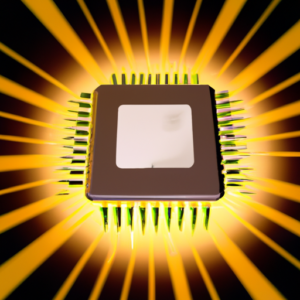Multi-core CPUs: The Future of Computing
Hey, guys! Today, I’m going to talk about multi-core CPUs and why they’re so important. Let’s start with the basics – what’s a multi-core CPU? Essentially, it’s a processor with multiple cores or separate processing units on a single chip. Unlike traditional single-core CPUs, multi-core CPUs can handle multiple tasks simultaneously, improving performance and power efficiency.
So, why are multi-core CPUs so beneficial? Well, for starters, they offer improved performance. With multiple cores, your computer can run programs faster and more efficiently. You can switch between apps and run complex tasks without any lag. Multi-core CPUs also allow for increased power efficiency. Instead of using one core to handle everything, your computer can distribute tasks across multiple cores, reducing power consumption overall.
Now, if you want to take full advantage of your multi-core CPU, you need to know how to harness its power. Here are a few strategies you can use:
First, it’s essential to write efficient code. A lot of developers write code that’s not optimized for multi-core CPUs. By learning how to optimize your code, you can make sure it’s utilizing all of your CPU cores.

Second, you should choose an appropriate programming language. Some programming languages are better suited for multi-core CPUs than others. For example, languages like Java and Python offer built-in support for multi-threading and can take advantage of multi-core CPUs.
Finally, you should consider utilizing parallel processing. By breaking down large tasks into smaller ones and running them simultaneously across multiple cores, you can take advantage of your CPU’s power.
In conclusion, multi-core CPUs offer a lot of benefits over traditional single-core CPUs. By learning how to harness their power, you can take your computing to the next level. So, if you’re not already using a multi-core CPU, it’s time to upgrade!
Benefits of Multi-Core CPUs
Let’s dive into the benefits of using multi-core CPUs for your computing needs!
First and foremost, multi-core CPUs offer improved performance compared to traditional single-core CPUs. With multiple cores working together, tasks can be divided and completed more efficiently, resulting in faster processing times and smoother performance.
In addition, multi-core CPUs also offer increased power efficiency. By distributing workloads across multiple cores, power consumption is reduced compared to a single-core CPU running at max capacity.
To fully harness the power of multi-core CPUs, it’s important to employ certain strategies. This includes writing efficient code that takes advantage of multi-threading and utilizing parallel processing whenever possible. It’s also important to consider the programming language being used, as some languages are better suited for multi-core processing than others.
Overall, the benefits of using multi-core CPUs are clear. Improved performance and power efficiency translate into a better user experience and cost savings in the long run. By understanding how to effectively utilize multi-core CPUs, you can take advantage of this technology to optimize your computing needs.
Strategies for Harnessing the Power of Multi-Core CPUs
Alright, now that we know how multi-core CPUs can benefit our computing experience, it’s time to talk about how we can best take advantage of them. The first tip I have is to write efficient code. This means optimizing your code so that it can effectively use all the cores available to you. You’ll want to avoid using too many global variables, minimize synchronization, and avoid locking code for long periods of time.
The next thing you’ll want to consider is choosing appropriate programming languages. Some languages, like C++ and Java, are better suited for multi-core computing than others. This is because they offer excellent threading and control over tasks. You’ll want to avoid languages like Python and Lua that offer active blocking, as this can limit multi-core efficiency.
Lastly, you’ll want to utilize parallel processing when possible. Parallel processing is where a task is split into sub-tasks and run simultaneously on different CPU cores. This can greatly increase processing power and allow for tasks to be completed much more quickly. However, it’s important to note that not all tasks can be efficiently parallelized. Some tasks must be done in a sequential order, so it’s important to analyze what tasks are best suited for parallel processing.
Overall, taking advantage of multi-core CPUs can greatly benefit your computing experience. By writing efficient code, choosing appropriate programming languages, and utilizing parallel processing, you can get the most out of your multi-core CPU and enjoy faster, more efficient computing.
Wrapping it up: Why Multi-Core CPUs are Worth the Effort
Well, folks, that’s a wrap! Overall, multi-core CPUs are worth the effort for those looking to improve their computing performance. They are faster, more efficient, and can handle more complex tasks than traditional single-core CPUs.
So, how can we best take advantage of multi-core CPUs? For starters, writing efficient code is of the utmost importance. Poorly written code can slow down even the most robust CPU. Also, choosing the right programming language can make a noticeable difference in performance. Focusing on parallel processing can also help streamline computing tasks, saving you valuable time and energy.
But why bother with the extra effort? Well, the benefits of utilizing multi-core CPUs can mean the difference between completing a task just in time or missing an important deadline. It can mean having the processing power to complete an advanced technological project or not.
So, if you’re looking to take your computing performance to the next level, consider investing in a multi-core CPU and following the strategies outlined above. With a little effort, you’ll be well on your way to supercharging your computing abilities.